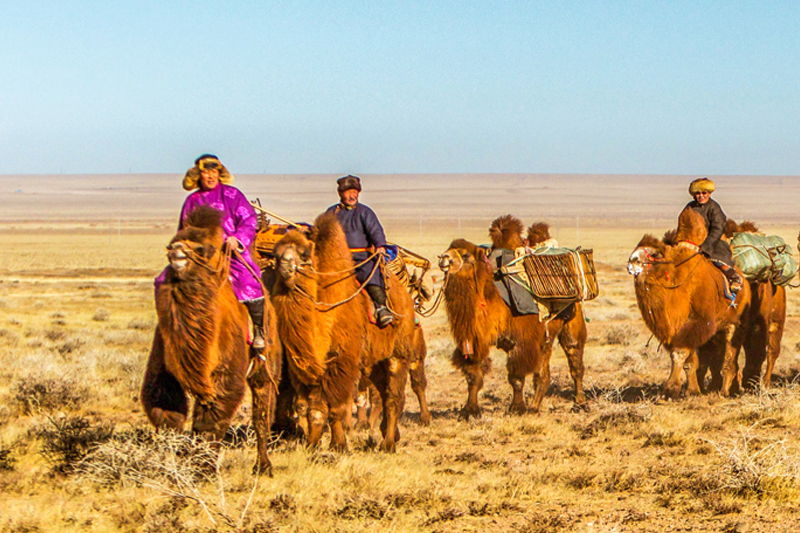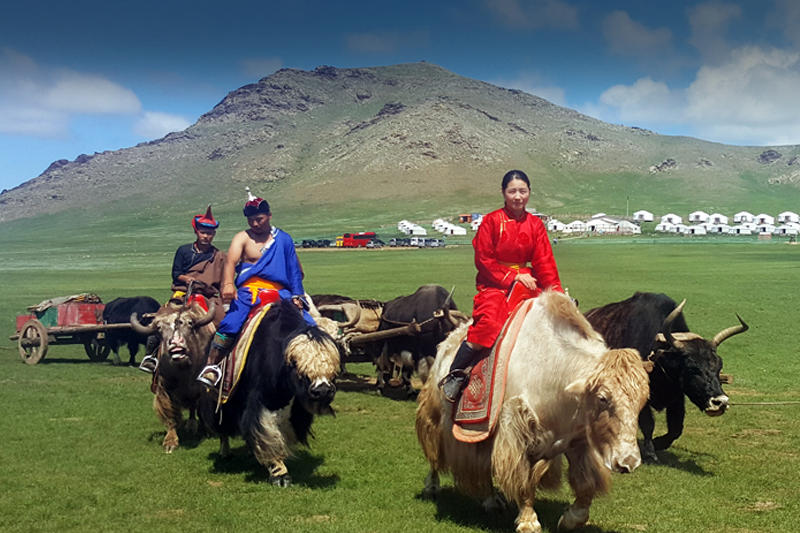- Home
- About Mongolia

Location: Between Siberian Russia and China, Area: 1,564,116km2 – the size of most of Western Europe, Relief: Mountains to the north, centre and southwest comprise 40% of the land; the remainder is rolling plateau with great expanses of steppe, semi-desert and desert plains, Highest point: Khuiten peak (4374m) in the Tavan bogd range in the Altai Mountains., Lowest point: Hoh Nuur (560 metres)...

Location: Between Siberian Russia and China Area: 1,564,116km2 – the size of most of Western Europe Relief: Mountains to the north, centre and southwest comprise 40% of the land; the remainder is rolling plateau with great expanses of steppe, semi-desert and desert plains. Highest point: Khuiten peak (4374m) in the Tavan bogd range in the Altai Mountains. Lowest point: Hoh Nuur (560 metres) Climate: Continental, marked by four seasons, with sharp variations.
Read more
Language: Mongolia (an Altaic language); Russian and English widely spoken Mongolian scrips: Mongolia has used a number of scripts throughout its history but the most used has been the Uighur Mongolian scrip. Uighur Mongolia script- In 1204 – today, created by the Tata-Tonga. Galik alphabet- In 1587, created by the translator and scholar Ayuush Gььsh Todo alphabet- In 1648, created by the Oirat Buddhist monk Zaya Pandita Phags-pa script (Square script) - In 1269, designed by the Tibetan monk Drogцn Chцgyal Phagpa for Kublai Khan, the founder of the Yuan dynasty
Read moreMongolia is a fabulous wide-open land of extreme climate and extraordinary natural environment. It’s tough at times and even bitterly cold, with surprise snow showers in summer. Travellers might face other climatic challenges, like having to ford rivers in full flood. It has a highly distinct set of Geographical features, caused by the area being an ancient dry land (once, over 200 million years ago, an inland sea),with an average elevation of 1,580m. The country lies between latitude 420 and 520N and longitude 870 and 1190E, and extends for 2392km from west to east and 1,259km from north to south. The total area is 1,564,116km2, over six times the land area of the UK and nearly three times that of France. It is the fifth-largest country in Asia. Mongolian total territory is divided 4 main zones by geography.
Mongol Empire of Genghis Khan is the biggest Empire of History.

700,00B.C.: First signs of human activity in present day Mongolia Circa 200 B.C.: Hunnu Empire established 552 to circa 900 A.D Syanbu State, Jujian State, Turkic Khaganate, Uighur Khaganate. 900 to 1100: Kidan Empire 1162: Temuujin is born 1196 to 1205: Temuujin unities Mongol tribes, founds Great Mongolian State and is proclaimed Great Chinggis Khan
Read more
Mongolia is rich with monuments and complex heritage sites that belong to Bronze Age culture. The main Bronze Age monuments are khirgisuurs, petroglyphs, stone sculptures such as deer stones and burial sites.
Read moreThe Mongols constitute one the principal ethnographic divisions of Oriental, or Asian peoples. Over time the once great corridor of migration across the northern grasslands between Hungary in the west and Manchuria in the east, became blocked by manmade divisions in the name of civilization. The origin of the Mongols themselves is from the Tungus people (The modern Evenki of southeast Mongolia) from Siberia and Manchuria and in the west from Huns (Xiongnu) and the Turks that lived in Mongolia and north China and moved westwards.
Although the population of Mongolia 3,177,899 in 2018, it has consisted of many different nomadic tribes from ancient times until the present day. Population figures are given for the various national groups described below. These figures and percentages are based on 2010 census figures.

The Mongols constitute one the principal ethnographic divisions of Oriental, or Asian peoples. Over time the once great corridor of migration across the northern grasslands between Hungary in the west and Manchuria in the east, became blocked by manmade divisions in the name of civilization. The origin of the Mongols themselves is from the Tungus people (The modern Evenki of southeast Mongolia) from Siberia and Manchuria and in the west from Huns (Xiongnu) and the Turks that lived in Mongolia and north China and moved westwards.
Read more
Most Mongolians now live in urban centres and visit relatives in the country. Of Mongolia’s 3,177,899 million people only 35% live as nomads or semi nomads away from towns and they are almost totally dependent on animal herding for their livelihood. But of the total population fewer than 15% are fully nomadic, that is to say, constantly on the move. However, at heart, every Mongolian is a nomad.
Read more
Culture is born of history, language and ideas, and many other invisible strands that make up and characterise a distinct group of people like the Mongols. The Mongolian national identity and culture is best seen in practice in the life and traditions surrounding the ger, the nomad’s home, and to a lesser extent in urban life through social costume and business practices. It is clearly present in religious celebrations, national festivals, sport, music, theatre and film.
Read more
When the Mongolian empire collapsed, the majority of Mongols return to their beloved uplands. They settled back to their usual herding occupations and fought among themselves – forgetting about military conquests. Despite such isolation, the Mongol language was greatly enriched by its international past.
Read more
Kublai Khan appointed a Tibetan lama, Phagspa Lama, to be the spiritual leader of his Yuan dynasty. Phagspa Lama interpreted Mahayana Buddhism so as to make Kublai Khan a Buddhist ‘universal king’ – an important agreement giving Kublai the temporal power and Phagspa the religious power.
Read more
The country’s most striking art form is the unique traditional Mongol zurag painting, a type of story – telling art without words that may be described as a developed form of naive painting. Mongol zurag portrays everyday country life with images of people, horses and gers, combined with folk motifs and legends. Fine line drawings were coloured with natural mineral pigments, such as red ochre and charcoal, until lacquer paints became available in Mongolia.
Read more
In former times, Mongol women wore traditional silver and coral jewellery – rings, necklaces, earrings and pins, Head and hair decorations (for married women) divided the hair into extraordinary-looking ‘wings’ on each side of the head. The hair was clipped back with silver pins, plaited and passed through two silver tubes that dropped to the waist on both sides. Mongolian men still carry embroidered pouches for their drinking bowls and tobacco, which are tucked into their sashes, along with a modern cigarette lighter instead of the ancient flint and steel!
Read moreShamanism and folk religion have ancient roots. But as the Mongol Empire expanded, the Mongols came into contact with Nestorian Christianity, Buddhism and Islam. Each established some influence at the Mongol court. Genghis Khan seems to have been interested in Tibetan Buddhism and Christianity, although this bred rivalry among the shamans. It is said that Genghis Khan was interested in all religions and in none. He drew his power from the Eternal Blue Heaven – like the Chinese emperor, the Son of Heaven. Mongolia was converted to Tibetan-style Buddhism twice, first by the example of Kublai Khan, Genghis Khans grandson, who adopted it as the state religion in the 13th century, and again in the 16th century, when Altan Khan took Buddhist vows and created the title Dalai Lama for the Tibetan leader. At the end of the 20th century there were some 136 registered monasteries, temples, mosques and churches in Mongolia.

Buddhism is a world religion with a historical founder, Prince Siddhartha Gautama. He is thought to have lived between 563вc and 483вс. Buddhism, like Hinduism, teaches that reincarnation (a cycle of death and rebirth) is based on karma (acts or deeds). When Buddha became ‘enlightened’, he achieved a blissful state known as nirvana. In so doing he eliminated the causes and cycle of rebirth. The Buddhist doctrine contains ‘Four Noble Truths’ and the ‘Noble Eightfold Path. The Four Noble Truths state the following:
Read more
This religion, the oldest religion practiced in Mongolia, centres on beliefs and rituals associated with a shaman, a man or woman regarded as having access to the ‘spirit world’. Mongolian shamans enter an ecstatic trance state in which the shaman is empowered to engage with the spirits in order to protect and heal members of the community, to guide souls and cure illnesses. Shamanism is found in many primitive cultures like those of the Siberian Tungus, from whose language the word ‘shaman’ (saman) derives.
Read more
Islam is an Arabic word meaning submission’. Muslims submit to Allah – God. The word of God was revealed to the Prophet Muhammad (born in570AD) and written down in the sacred book the Koran (Qur’an). Islam is very simple religion with a five-fold path (see below) and consists of belief in the oneness of God. Mecca is the city where the prophet Muhammad died in 632ad and is a place of pilgrimage for all Muslims.
Read more
Christians believe there is one God, who created the Universe, and that in this one God there are three persons, known as the Holy Trinity; God the Father, his Son (Jesus Christ) and the Holy Spirit. Those who believe become Christians by being baptized – that is, they receive the Holy Spirit and become children of God. Jesus entered history by taking on human flesh and being born of a virgin, Mary. He was fully human but retained his divine nature.
Read more